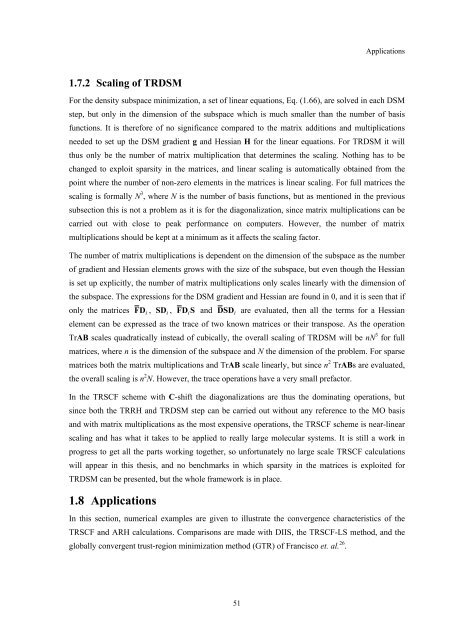Get my PhD Thesis
Get my PhD Thesis
Get my PhD Thesis
You also want an ePaper? Increase the reach of your titles
YUMPU automatically turns print PDFs into web optimized ePapers that Google loves.
Applications<br />
1.7.2 Scaling of TRDSM<br />
For the density subspace minimization, a set of linear equations, Eq. (1.66), are solved in each DSM<br />
step, but only in the dimension of the subspace which is much smaller than the number of basis<br />
functions. It is therefore of no significance compared to the matrix additions and multiplications<br />
needed to set up the DSM gradient g and Hessian H for the linear equations. For TRDSM it will<br />
thus only be the number of matrix multiplication that determines the scaling. Nothing has to be<br />
changed to exploit sparsity in the matrices, and linear scaling is automatically obtained from the<br />
point where the number of non-zero elements in the matrices is linear scaling. For full matrices the<br />
scaling is formally N 3 , where N is the number of basis functions, but as mentioned in the previous<br />
subsection this is not a problem as it is for the diagonalization, since matrix multiplications can be<br />
carried out with close to peak performance on computers. However, the number of matrix<br />
multiplications should be kept at a minimum as it affects the scaling factor.<br />
The number of matrix multiplications is dependent on the dimension of the subspace as the number<br />
of gradient and Hessian elements grows with the size of the subspace, but even though the Hessian<br />
is set up explicitly, the number of matrix multiplications only scales linearly with the dimension of<br />
the subspace. The expressions for the DSM gradient and Hessian are found in 0, and it is seen that if<br />
only the matrices FD i , SD i , FDiS and DSD i are evaluated, then all the terms for a Hessian<br />
element can be expressed as the trace of two known matrices or their transpose. As the operation<br />
TrAB scales quadratically instead of cubically, the overall scaling of TRDSM will be nN 3 for full<br />
matrices, where n is the dimension of the subspace and N the dimension of the problem. For sparse<br />
matrices both the matrix multiplications and TrAB scale linearly, but since n 2 TrABs are evaluated,<br />
the overall scaling is n 2 N. However, the trace operations have a very small prefactor.<br />
In the TRSCF scheme with C-shift the diagonalizations are thus the dominating operations, but<br />
since both the TRRH and TRDSM step can be carried out without any reference to the MO basis<br />
and with matrix multiplications as the most expensive operations, the TRSCF scheme is near-linear<br />
scaling and has what it takes to be applied to really large molecular systems. It is still a work in<br />
progress to get all the parts working together, so unfortunately no large scale TRSCF calculations<br />
will appear in this thesis, and no benchmarks in which sparsity in the matrices is exploited for<br />
TRDSM can be presented, but the whole framework is in place.<br />
1.8 Applications<br />
In this section, numerical examples are given to illustrate the convergence characteristics of the<br />
TRSCF and ARH calculations. Comparisons are made with DIIS, the TRSCF-LS method, and the<br />
globally convergent trust-region minimization method (GTR) of Francisco et. al. 26 .<br />
51

















